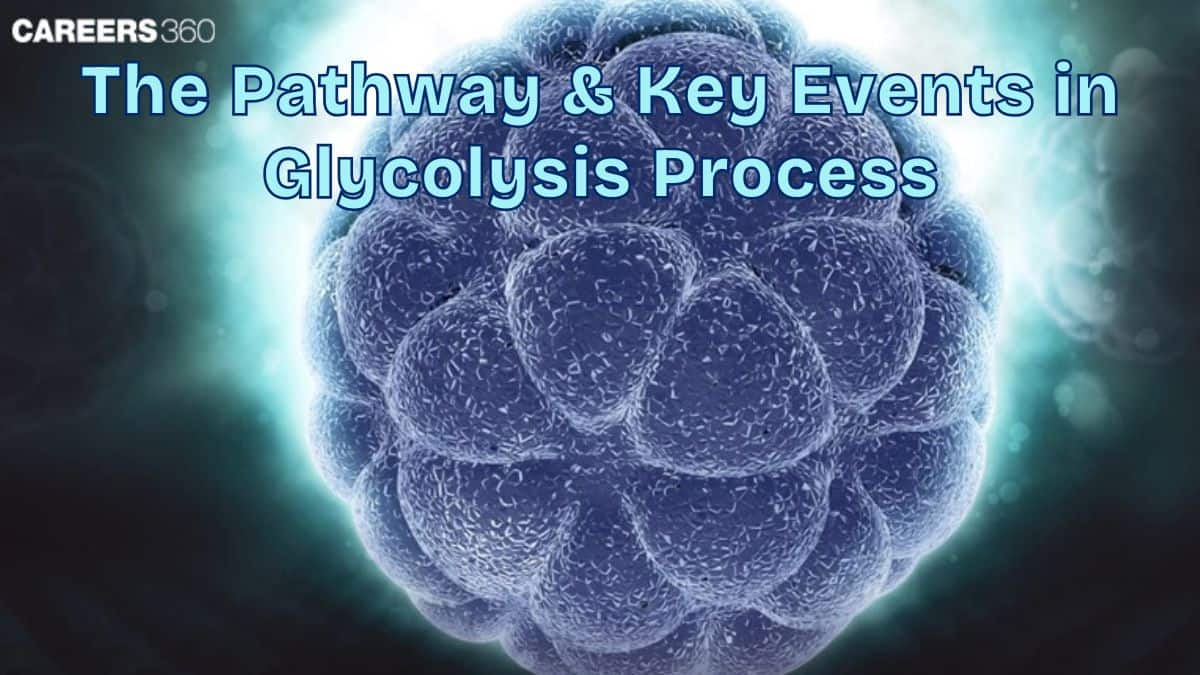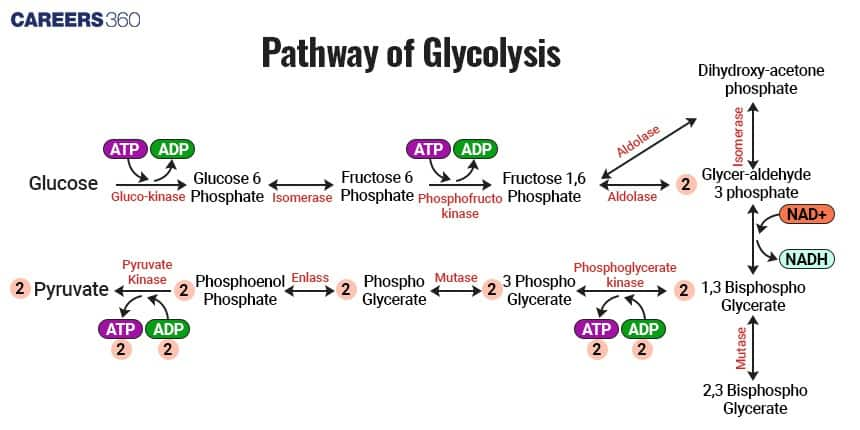The Pathway And Key Events In Glycolysis Process: Pathway, Steps & Products
The glycolysis pathway is a 10-step enzymatic process that breaks down one molecule of glucose into two molecules of pyruvate. It occurs in the cytoplasm and produces a net gain of 2 ATP and 2 NADH, making it essential for both aerobic and anaerobic respiration. Understanding each step, enzyme regulation, and energy yield is key for NEET & Class 11 Biology.
This Story also Contains
- What Is Glycolysis?
- Steps of Glycolysis (10 Steps, Enzyme-Wise)
- Regulation of Glycolysis
- Energetics of Glycolysis
- Fate of Pyruvate After Glycolysis
- Importance of Glycolysis
- Glycolysis NEET MCQs (With Answers & Explanations)
- Recommended Video On 'The Pathway and Key Events In Glycolysis Process'

What Is Glycolysis?
Glycolysis is the metabolic pathway by which the six-carbon sugar glucose is broken down into two molecules of the three-carbon compound, pyruvate. It akes place in the cytoplasm of a cell and is also the first stage of cellular respiration. This process is important in that it yields a net gain of two ATP molecules and two NADH molecules to the cell and meanwhile injects energy and reduces the power that these end products can easily be converted to other metabolic processes.
The first stage is glycolysis of cellular respiration. It takes place under both aerobic and anaerobic conditions. In the presence of oxygen, through glycolysis and then into a second pathway in the mitochondria called the citric acid cycle, followed by oxidative phosphorylation, in which glucose is fully oxidised with a high yield of ATP. Under anaerobic conditions, glycolysis leads to fermentation, where the cells can produce ATP without oxygen. This flexibility makes glycolysis a central pathway to energy production in an extraordinarily large number of organisms.
Steps of Glycolysis (10 Steps, Enzyme-Wise)
The pathway of glycolysis is further divided into two phases: energy investment phase and energy payoff phase.
The first 5 of which constitute the energy investment phase, in which the energy of ATP is invested. The energy gain comes in the energy payoff phase of glycolysis, i.e. from step 6 to 10.
Phase 1 – Energy Investment Phase (Steps 1–5)
Step 1: Glucose to Glucose-6-Phosphate
Enzyme: Hexokinase
Catalyses the phosphorylation of glucose to glucose-6-phosphate.
1 ATP consumed, ATP donates a phosphate group, converting it to ADP.
Step 2: Glucose-6-Phosphate to Fructose-6-Phosphate
Enzyme: Phosphohexose isomerase
1 ATP consumed, ATP is spent to phosphorylate a molecule and it is regenerated back to ADP.
Key regulatory step in glycolysis
This reaction step is tightly regulated by intracellular levels of ATP.
Step 3: Fructose-6-Phosphate to Fructose-1,6-Bisphosphate
Enzyme: Phosphofructokinase
Adds a second phosphate group to fructose-6-phosphate, forming fructose-1,6-bisphosphate.
Key regulatory step in glycolysis
This step is highly regulated by cellular energy levels.
Step 4: Fructose-1,6-Bisphosphate to DHAP and G3P
Enzyme: Aldolase
Fructose-1,6-bisphosphate is cleaved into two three-carbon molecules: dihydroxyacetone phosphate and glyceraldehyde-3-phosphate.
Products is dihydroxyacetone
Converts DHAP to G3P, so that two G3P passes through glycolysis.
Step 5: Conversion of DHAP to G3P
Enzyme: Triose phosphate isomerase
Converts DHAP to G3P, ensuring that two molecules of G3P proceed through glycolysis.
Phase 2 – Energy Payoff Phase (Steps 6–10)
Step 6: G3P to 1,3-Bisphosphoglycerate
Enzyme: glyceraldehyde-3-phosphate dehydrogenase
Catalyzes the oxidation and phosphorylation of G3P to produce 1,3-bisphosphoglycerate
1NADH per G3P
NAD+ is reduced to NADH at this step
Step 7: 1,3-Bisphosphoglycerate To 3-Phosphoglycerate
Enzyme: Phosphoglycerate kinase
Transfers a phosphate group from 1,3-bisphosphoglycerate to ADP, forming ATP and 3-phosphoglycerate.
1 ATP per G3P
This step produces one molecule of ATP for each G3P.
Step 8: 3-Phosphoglycerate To 2-Phosphoglycerate
Enzyme: Phosphoglycerate mutase
Converts 3-phosphoglycerate reversibly to 2-phosphoglycerate by shifting the position of a phosphate group from the third to the second carbon.
Step 9: 2-Phosphoglycerate To Phosphoenolpyruvate
Enzyme: Enolase
Dehydrates 2-phosphoglycerate to form phosphoenolpyruvate (PEP), removing a molecule of water.
1 Water molecule removed per G3P and released as a byproduct.
Step 10: Phosphoenolpyruvate To Pyruvate
Enzyme: Pyruvate kinase
Transfers a phosphate group from PEP to ADP, forming ATP and pyruvate.
1 ATP per G3P
This step produces one molecule of ATP for each G3P.
Regulation point: Second key regulatory step
This step is regulated to ensure efficient energy production.

Regulation of Glycolysis
Glycolysis is closely regulated to ensure that the generation of energy is highly efficient and integrated with the cell.
Regulatory Enzymes
Hexokinase: The enzyme catalysing the phosphorylation of glucose to glucose-6-phosphate is inhibited by the product of the reaction, glucose-6-phosphate.
Phosphofructokinase: This enzyme controls the step of conversion from fructose-6-phosphate to fructose-1,6-bisphosphate; a major regulatory step affected by ATP, AMP, and citrate levels.
Pyruvate kinase: This is the final step in the conversion of phosphoenolpyruvate to pyruvate and is regulated by the levels of ATP and alanine, while it is activated by fructose-1,6-bisphosphate.
Mechanisms Of Regulation
Allosteric regulation: Enzymes like phosphofructokinase are regulated through binding at places other than the active site of the enzyme, thereby modifying its activity.
Feedback inhibition: The end products like ATP will inhibit the early steps of glycolysis so that overproduction can be avoided.
Hormonal regulation: Insulin enhances glycolysis by increasing the expression of most glycolytic enzymes, while glucagon inhibits glycolysis to enhance gluconeogenesis.
Energetics of Glycolysis
Glycolysis generates energy in the form of ATP and NADH through its activity and is, therefore, an important aspect of cellular metabolism.
ATP Yield
In glycolysis, while 4 ATP molecules per glucose are produced, 2 ATP are consumed. Hence, there is a net gain of 2 ATP.
NADH Production
The NADH produced during glycolysis in each glucose molecule passes high-energy electrons into the electron transport chain in the mitochondria, which leads to additional production of ATP.
Overall Energy Efficiency
Part of the energy from the glucose is captured and stored as ATP and NADH during glycolysis while still having some energy remaining in pyruvate, which can be further oxidised in the presence of oxygen.
Fate of Pyruvate After Glycolysis
The metabolic fate of pyruvate after glycolysis is:
Aerobic Conditions
In the presence of sufficient oxygen, pyruvate is transported into the mitochondria and then converted to acetyl-CoA by the pyruvate dehydrogenase complex. The produced acetyl-CoA will enter the citric acid cycle (Krebs cycle), where it becomes further oxidized into ATP, NADH, and FADH2 required for the electron transport chain.
Anaerobic Conditions
In the absence of, or when oxygen is limited, the cells resort back to anaerobic pathways for energy generation.
In lactic acid fermentation, when the amount of oxygen is inadequate during exercise or when oxygen demand is high, pyruvate is converted to lactate.
Alcoholic fermentation in yeast and some bacteria, pyruvate is converted to ethanol and carbon dioxide through alcoholic fermentation.
Importance of Glycolysis
The importance of glycolysis is:
It is a universal metabolic pathway occurring in both prokaryotes and eukaryotes.
It helps in the rapid generation of the ATP.
It helps prepare the substrate that will be further used in the Krebs cycle.
It maintains the supply of oxygen during low oxygen conditions
Glycolysis NEET MCQs (With Answers & Explanations)
Important topics for NEET are:
Steps in Glycolysis
Regulation of Glycolysis
Fate of Pyruvate
Practice Questions for NEET
Q1. What is the role of NAD+ in cellular respiration?
It is a nucleotide source for ATP synthesis.
It functions as an electron carrier.
It functions as an enzyme.
It is the final electron acceptor for anaerobic respiration.
Correct answer: 2) It functions as an electron carrier.
Explanation:
At various chemical reactions, the NAD+ picks up an electron from glucose, at which point it becomes NADH. Then NADH, along with another molecule, flavin adenine dinucleotide (FADH2), will ultimately transport the electrons to the mitochondria, where the cell can harvest energy stored in the electrons.
Hence, the correct answer is Option (2) It functions as an electron carrier.
Q2. In terms of quantity, oxidation of 1 glucose molecule yields
686 Kcal energy
782 Kcal energy
656 Kcal energy
608 Kcal energy
Correct answer: 1) 686 Kcal energy
Explanation:
There is about 686 kcal oxidation for each glucose molecule. Cellular respiration breaks glucose into carbon dioxide and water. The theoretical maximum yield of ATP in this process is about 30 to 38 ATP molecules depending on the efficiency of electron transport and conditions prevailing in the cell. Practical yields are usually much lower because there is a loss of energy in transport and other metabolic processes.
Hence the correct answer is Option 1. 686 Kcal energy.
Q3. The number of ‘ends’ in a glycogen molecule would be
Equal to the number of branches plus one
Equal to the number of branch points
One
Two, one on the left side and another on the right side
Correct answer: 4) Two, one on the left side and another on the right side
Explanation:
One should remember that the number of ‘ends’ in a glycogen molecule would be equal to the number of branches plus one. This is because glycogen is a branched polysaccharide, with each branch terminating in a free non-reducing end. The main chain contributes one end, while each additional branch adds another. These ends are crucial for enzymatic action during glycogen synthesis and breakdown. Enzymes like glycogen phosphorylase act on these non-reducing ends to release glucose-1-phosphate during glycogenolysis.
Hence, the correct answer is option 4)Two, one on the left side and another on the right side.
Also Read:
Recommended Video On 'The Pathway and Key Events In Glycolysis Process'
Frequently Asked Questions (FAQs)
The glycolysis process involves three major steps: the energy investment phase.
During the process of glycolysis, which involves glucose, it produces only 4 ATP molecules, but 2 ATP will be used during the process. In this way, 2 ATPs are made.
Glycolysis is a series of reactions that yield high-energy electrons that convert NADH from NAD+, which can then transport the electrons to the mitochondrial electron transport chain. There, NADH donates the electrons to generate ATP.
Glycolysis is regulated through allosteric regulation, negative feedback, and hormonal control, at three main regulatory points, these three enzymes are hexokinase, phosphofructokinase, and pyruvate kinase respectively.
The function of glycolysis is to provide ATP and NADH for immediate energy demands; it also forms pyruvate as an intermediate for further energy production during the process of aerobic respiration.